
Government contracting can be volatile at times, with programs being at risk, under a stop-work order, or even canceled. This can create challenges to the back-office maintenance of the contracts in your Deltek Costpoint environment. In this article, we will discuss how to navigate these challenges properly. We’ll also explore key tools and best practices in Deltek Costpoint to help streamline your contract close-out process. Our goal is to help you mitigate potential risk and maintain project control in your system.
Is Your Billing Current?
One of the best ways to ensure you are prepared for a contract close-out is to ensure that your billing is current and accurate. You want to ensure that all Time & Expense entries are approved and posted, costs are properly allocated to the correct project codes, GL accounts, and orgs, and that your subledgers (unbilled analysis, AR Aging, etc.) tie to your general ledger.
Prior Year Retro Bills
Retroactive rate adjustment invoices are best done yearly. Say it one more time now, retroactive rate adjustment invoices are best done yearly. These become more of a hassle and a headache the further back we go in the life of a project. Having these up to date and reconciled will ensure a smoother contract close-out process. For more information on retroactive indirect rate true-up invoicing, please read our article, “Deltek Costpoint Indirect Rate True-Up Invoicing.”
Monitoring Budget versus Actuals
Tracking your budget versus actuals is one of the most vital practices to ensure financial stability. This is your safety net! This practice helps you remain compliant and provides a proactive approach to mitigating financial risk, rather than a reactive one.
- Are you missing anticipated costs?
- Are you over- or under-running your project?
- Is revenue accurate?
Utilizing Deltek Costpoint’s Project Status Reports (PSRs) and Estimates at Completion (EACs) can help ensure that you are accurately tracking and reporting costs. Timely and consistent tracking of your budget versus actuals will inform you BEFORE there is a problem.
Vendor and Subcontractor Invoices
It is common for your vendor and subcontractor invoices to be the most delayed components of your cost data. This can have a negative impact on billings, funding ceilings, and revenue if you are not tracking this carefully. You cannot close what is not complete! Implement a rigid schedule with your vendors and subcontractors, and closely track which invoices are pending or have not been received in a timely manner.
Stop Work
In the event of a stop work, in addition to communicating with all impacted employees, you may consider implementing additional controls in timekeeping to alert employees that the charge leg is no longer available. Deltek Costpoint offers options to prevent charging at an overall level and on a person-by-person basis.
At an overall level, in the Projects section of T&E, use the drop-down box to add a hard edit (no charging can be added at all) or soft edit (a warning appears). The dates that appear come from Manage Modifications. However, this will only occur if the modification is at the charging level. If the modification is stored at a higher level of the project, you will have to manually enter the dates by checking the “override start/end dates” checkbox.
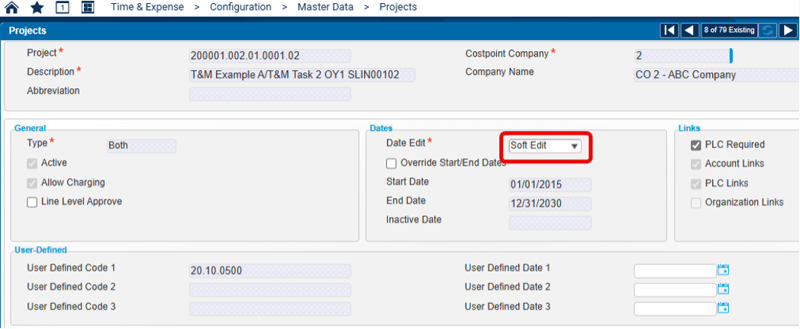
If you prefer to manage charging by person, you can use the start/end dates in the Manage Employee Workforce screen. This will populate an error if the employee tries to use that charge code on their timesheet outside of the specified range.
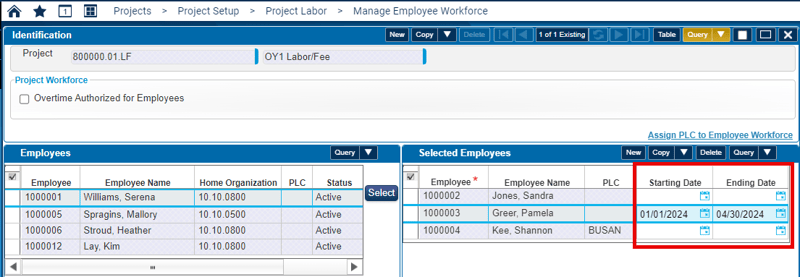
At Risk Work
What do we mean when we say a project is “at risk”? This refers to a contract awaiting funding or formal award, a signed modification awaiting additional funding, a stop-work order, or out-of-scope work that hasn’t been finalized – essentially, this means costs are being incurred before funding is approved and authorization to proceed is granted. You will inevitably face “at-risk” work in government contracting. Let’s discuss the three things you need to consider regarding “at-risk” cost.
1. How to Track “At-Risk” Costs
The first thing you need to consider is how to track “at-risk” costs. Our recommendation is that you have clearly defined “at-risk” project nodes within your contract’s project structure. The ability to properly track costs is dependent on collecting them so that they are not intermingled with other WBS or cost elements on the project. By breaking out the “at risk” cost this way, you can utilize the project status reports (PSRs) to ensure proper project controls and tracking.
2. How to Recognize Revenue on “At Risk” Costs
The next item to consider is whether and how you recognize revenue on “at-risk” costs. Whether or not you recognize revenue depends on your confidence in receiving the funds. If you have high confidence in receiving funding or a fully executed mod, you may decide to recognize revenue as the cost is incurred. With this method, you will want to utilize the Ceilings Functionality in Deltek Costpoint to ensure you are not billing the “at-risk” cost.
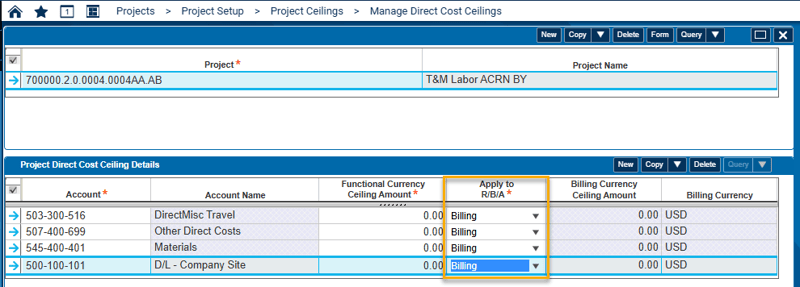
You can track the difference in billings and revenue using the Unbilled Receivables Analysis Report.
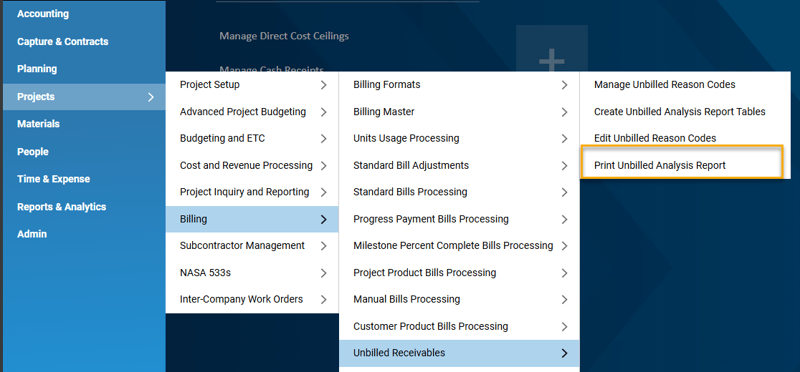
If you have little confidence or a history of delays with the customer, you may decide to defer revenue recognition until the funding is received. With this method, you would set your “at risk” cost project nodes to “unbillable” utilizing an unbillable project account group (PAG). The accounts in this PAG would utilize the “unallow” account function codes. The costs assigned to these function codes are included as legitimate costs on the project but will be excluded from revenue and billing calculations.
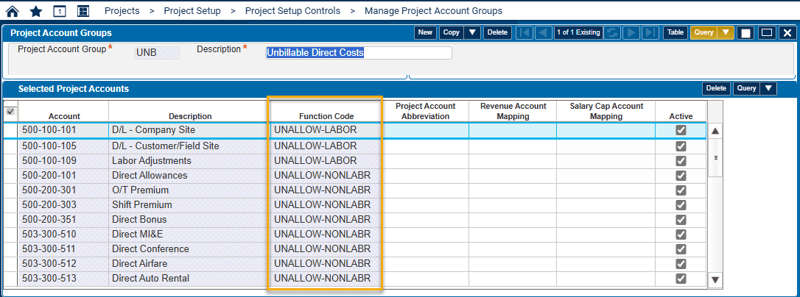
3. Will You Recoup the Costs Incurred?
Last and certainly not least, what is the reasonability that you will recoup the costs incurred?
- Has the mod been initiated for the work?
- Does your prior relationship with the customer provide confidence that you will receive payment?
- What is the value of the “at risk” cost incurred compared to the contract ceiling and/or remaining funding ceiling?
The ability to track the “at-risk” costs and evaluate the reasonability of recouping those costs is vital. Know your risk and take action to protect your organization.
Project Completion
Once a project is complete, whether due to early termination or the end of the period of performance, you can easily track close-out activities using Deltek’s Capture & Contracts module. Using this checklist, you can assign tasks and mark them as they are completed. We provide a full overview of this module in our article, “Connect Data from Opportunity to Close-out with Deltek’s Costpoint CRM & Contracts Module.”
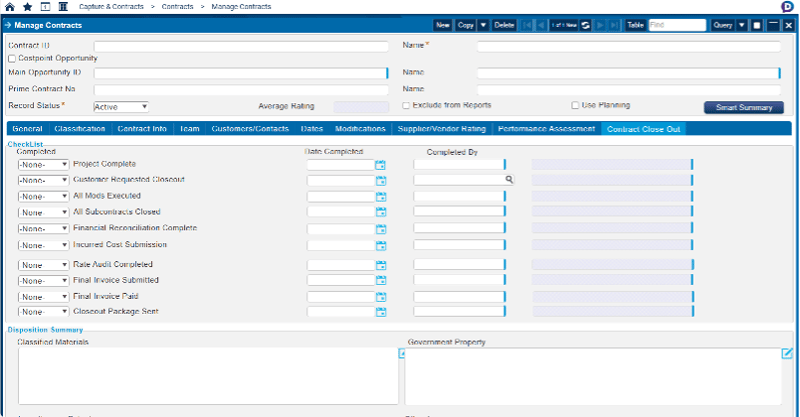
As part of your financial reconciliation:
- Have you established close-out procedures with your subcontractors and received all their final billings? Have you received and posted all of your bills from your vendors?
- Have all purchase orders been executed or marked to exclude, clearing your organization’s commitment reports?
- Internally, have you processed all relevant expense reports and timesheets?
By the project's end, your revenue should equal your billings, resulting in a zero balance in your unbilled receivables account. For more information on unbilled receivables, refer to our article, “Understanding Deltek Costpoint Unbilled Receivables.” It’s a best practice to regularly review the balances in your Unbilled Accounts to understand what is driving the differences and if they simply relate to timing or if adjustments might be needed. If adjustments are made, journal entries should not be made to unbilled or revenue accounts.
Conclusion
Government contracting can sometimes be a volatile industry, with customer needs changing rapidly. Utilizing Deltek Costpoint to its full capabilities can keep your administrative team nimble and able to maintain accurate records throughout at-risk work, closeouts, and subsequent new awards. Setting up new at-risk projects, using timesheet end dates and updating the close-out screens seems like more work on the front end. However, it is much easier to keep things organized while the information is fresh, rather than waiting for years and scrambling to complete close-outs when the government or customer finally requests them.
Supporting Smarter Project Close-Outs and Risk Management
Navigating contract terminations and at-risk work requires more than just good software; it requires experience and foresight. Redstone GCI’s team of experts helps government contractors implement practical controls, reconcile cost data, and manage project transitions efficiently. From system configuration to billing reviews and training, we work alongside your team to strengthen compliance and streamline your back-office processes. If your team needs support with accounting processes, at-risk work, stop work, or contract close-outs, our Deltek Costpoint consultants are here to help.

